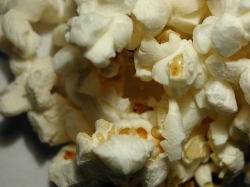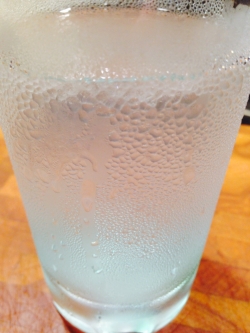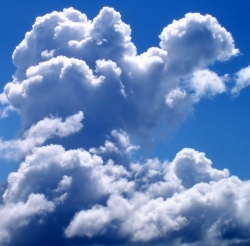Right now, you might be looking through water to read this computer screen. You read that right: water. Water in gas form is in the air. Have you ever seen steam rising up from a hot plate of food? That steam is water vapor, or water in gas form. Water does not just fall from the sky, it hangs out in the air all around us. I hope you brought your swimsuit!
Air is made up of lots of different things, like oxygen and other gases, dust, and even water in gas form. You can think of air like a bag of microwave popcorn. The corn seeds inside the bag are molecules, the building blocks of things, like oxygen or water or pieces of dust. When you add heat, the popcorn starts to race around inside the bag. The hotter the popcorn gets, the faster the popcorn moves "" just like the air around you. All this racing around in the air keeps the water molecules from sticking together and forming drops of water. When the air gets really hot, it can hold a lot more water than cold air. The hot air keep running into the water, stopping it from becoming a whole drop of water.
Humidity is a measure of how much water vapor is in the air.

Pop another bag for me please!
Paolo Neo, Public domain, via Wikimedia Commons
At some point, the air cannot hold any more water in gas form. Think about that bag of popcorn. There's only so much room inside. Once the popcorn pops, the bag gets pretty crowded. Air gets crowded with water vapor too. When that happens, the water starts to stick together and form drops. You may have seen drops of water form on the side of a cold glass of water on a hot day. What makes this happen? The cold water inside of your glass cools the air around it and lets the water form into drops on the outside of the glass. The
dew point is the temperature where water starts to stick together to form drops. When it's hot outside, the dew point can be pretty high, meaning drops start to form at fairly high temperatures.

Hey, how did this water get all over the outside of my glass?
You can't see it, but the sun's heat turns water from swimming pools and puddles into a gas. Since the air molecules are moving so much faster, hot air tends to spread out and take up more space, making it lighter than cold air. Think back to that bag of popcorn. Once the popcorn is popped, it's lighter and takes up much more room in the bag compared to the unpopped popcorn. Hot air spreads out a lot, so it moves higher in the sky, where it starts to cool off. This cooling means the molecules do not move around as much, and they can start to stick together to make drops of water. Once water drops form in the air, they do not always fall straight from the sky as rain. Clouds may form instead.
Clouds are bunches of liquid water in the air that you can see. Clouds are either made of drops of water or pieces of ice that stick to pieces of dust or smoke.

I don't know about you but this cloud looks like a dragon's head to me.
Bratislav Tabaš, Public domain, via Wikimedia Commons
You can likely guess what the weather will be from one day to the next. In the summer, you may guess that you will have several sticky mornings followed by afternoon rain. Maybe you live in a place where it's hot and dry all summer long. In the winter, you may know that you will have several cold, dry days in a row. It might rain every day in the winter where you live. If we look at how air moves around, we can make better guesses about the weather. A
weather pattern is when the weather repeats so that we can predict what is going to happen. Weather patterns usually move from west to east. For example, hot weather may come to California before moving east to New York City.
Water doesn't just fall from the sky. In the air, water molecules sit alongside molecules of oxygen, other gases like carbon dioxide and even pieces of dust. We call the water vapor humidity. But as the air starts to cool off, water starts to form drops on pieces of dust or smoke in the sky, creating clouds. These clouds may finally get so heavy that raindrops fall. Then water is all around you. Water is actually always all around you. But sometimes you can see it, and sometimes you can't.
References:
"Cloud Classification and Characteristics" Weather
Forecast Office. National Weather Service, 2011.
<http://www.crh.noaa.gov/lmk/?n=cloud_classification>
Science Kids. "Introduction to Clouds" Science Kids, 2014.
<http://www.sciencekids.co.nz/videos/weather/clouds.html>
"Weather." National Geographic Education.
National Geographic, 2013.
<http://education.nationalgeographic.com/education/encyclopedia/weather/?ar_a=1>